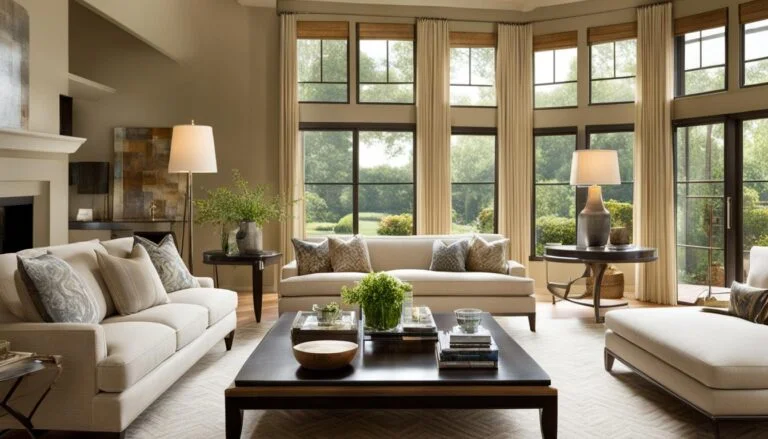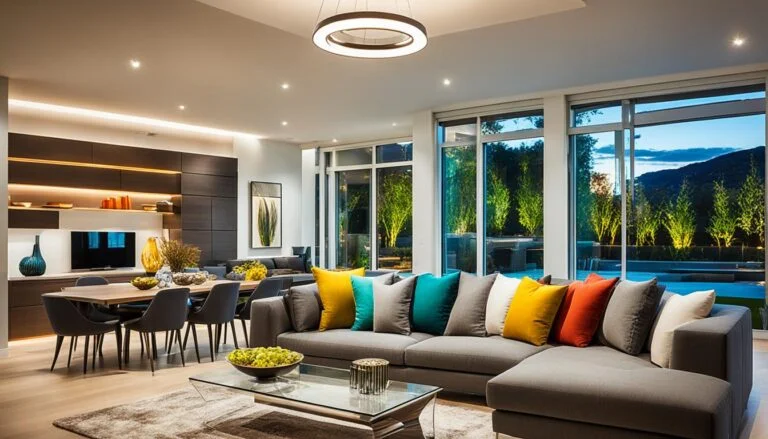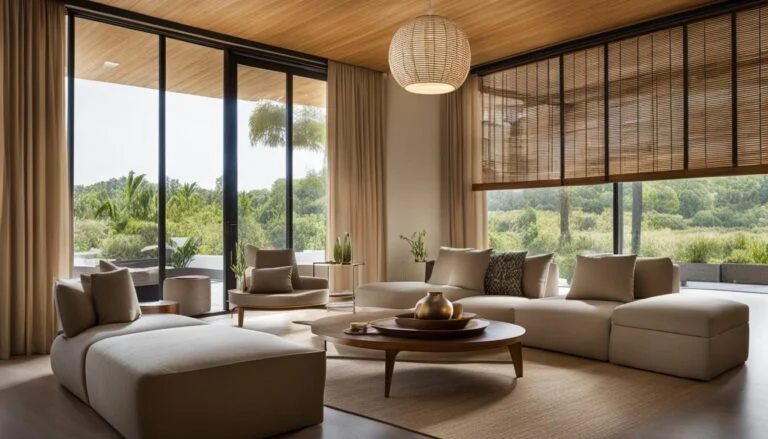Transitional interior design is a captivating style that blends the warmth and familiarity of traditional decor with the clean lines and minimalist approach of Classic Meets Contemporary. It creates spaces that are both timeless and modern, offering a versatile aesthetic that appeals to a wide range of tastes. The core principle of transitional design is balance, achieved through a thoughtful mix of textures, materials, and color palettes. Neutral colors, natural light, sophisticated furniture, and thoughtful layout are key elements of this style. Transitional design allows for personalization while maintaining a cohesive and elegant look in any room of the home.
Key Takeaways
- Transitional interior design merges Classic Meets Contemporary elements to create a timeless and modern aesthetic.
- The balance of textures, materials, and color palettes is essential in achieving a cohesive transitional design.
- Neutral colors, natural light, sophisticated furniture, and thoughtful layout are key elements of transitional interior design.
- Transitional design allows for personalization while maintaining a cohesive and elegant look in any room of the home.
- By combining classic and modern elements, transitional design creates spaces that are comfortable, functional, and visually appealing.
Timelessness: The Essence of Transitional Interior Design
Timelessness lies at the heart of transitional interior design, capturing the perfect blend of classic and modern elements. This design style harmoniously merges traditional and contemporary aesthetics, creating a luxurious and enduring environment that stands the test of time.
A neutral color palette forms the foundation of transitional design, using shades such as beige, taupe, and grey to evoke a sense of calm and understated elegance. These timeless colors provide a versatile backdrop that effortlessly complements both traditional and modern furniture and decor.
Natural light plays a crucial role in transitional design, enhancing the openness and warmth of the space. Large windows and open floor plans allow for the seamless flow of natural light, creating a bright and inviting ambiance. To further enhance the atmosphere, ambient lighting, such as well-placed table lamps, adds a soft and welcoming glow.
Sophisticated furniture and thoughtful layout are key elements of transitional design, striking the perfect balance between classic and modern. Timeless pieces with clean lines and elegant details offer a sense of tradition, while incorporating modern materials and finishes bring a contemporary touch.
“Transitional design is like a bridge that connects the past and the present, creating a space that is both familiar and refreshing. It allows homeowners to embrace their personal style while maintaining a cohesive and timeless aesthetic.”
Transitional design achieves a harmonious fusion of classic and modern elements, resulting in interiors that exude elegance, comfort, and sophistication. The timeless appeal of this design style ensures that it remains a popular choice for homeowners who desire a space that effortlessly blends the best of both worlds.
Harmonizing Materials and Textures in Transitional Design
Transitional design skillfully merges varied materials and textures to create a space that is both elegant and comfortable. This approach is particularly evident in the way different elements are combined to achieve a cohesive and sophisticated look. A key feature of this style is the artful combination of different materials, such as smooth stone, textured wood, glass, mirrored surfaces, and metal accents. These elements inject a contemporary feel while retaining a classic aesthetic.
The beauty of wood and the addition of metal details throughout the room add depth and a modern twist. Luxurious upholstery and varied textures in accessories enhance the overall comfort and visual appeal of the space.
“Transitional design skillfully merges varied materials and textures to create a space that is both elegant and comfortable.”
Materials in Transitional Design
In transitional design, the choice of materials plays a crucial role in achieving the desired aesthetic. By combining different materials, designers can create a harmonious and visually appealing space. Here are some common materials used in transitional design:
- Smooth stone: Creates a sleek and contemporary look, often used in countertops, backsplashes, and fireplace surrounds.
- Textured wood: Adds warmth and richness to the space, commonly used in flooring, cabinetry, and furniture.
- Glass: Provides a modern and airy feel, used in windows, doors, and decorative accents.
- Mirrored surfaces: Reflect light and create an illusion of space, incorporated in furnishings and decor.
- Metal accents: Add a touch of glamour and sophistication, used in lighting fixtures, hardware, and decorative elements.
Textures in Transitional Design
Textures play a vital role in creating visual interest and depth in transitional design. By incorporating diverse textures, designers can elevate the overall look and feel of a space. Here are some examples of textures commonly used in transitional design:
- Soft upholstery: Provides a sense of comfort and coziness in seating areas.
- Natural fibers: Bring an organic and earthy feel, commonly seen in rugs, curtains, and woven accessories.
- Patterned textiles: Add visual interest and create focal points in the space.
- Mixed metals: Create contrast and lend a modern touch to the design.
- Textured wall coverings: Add depth to the walls and create a sense of luxury.
Incorporating a variety of materials and textures in transitional design results in a versatile aesthetic that appeals to various design preferences, while maintaining a cohesive and elegant look.
| Material | Characteristics |
|---|---|
| Smooth Stone | Captivating sleekness and contemporary appeal |
| Textured Wood | Warmth, richness, and depth |
| Glass | Modern and airy feel, enhances light |
| Mirrored Surfaces | Reflects light and creates an illusion of space |
| Metal Accents | Glamour and sophistication |
Combining these materials with luxurious upholstery and varied textures in accessories results in a visually stunning and comfortable space that embodies the essence of transitional design.
Balancing Heritage and Innovation: Merging Traditional and Contemporary Architecture
The integration of traditional and contemporary architectural elements is vital in achieving a harmonious balance between heritage and innovation. While traditional architecture represents cultural heritage and is deeply rooted in history, contemporary architecture embraces innovation, functionality, and sustainable practices.
By combining these two distinct styles, we are able to preserve our heritage while meeting the evolving needs of modern society. It is a delicate dance of paying homage to the past while embracing the future.
When it comes to balancing heritage and innovation in architecture, several key factors come into play:
- Respecting Historical Context: By understanding and respecting the historical context of a site or building, architects can seamlessly integrate traditional and contemporary elements. This ensures that the past is honored and celebrated while creating a design that is relevant to the present.
- Adapting Traditional Elements: Traditional architectural features can be reimagined and adapted to meet contemporary needs. This allows for a seamless blend of old and new, creating a design that is both familiar and fresh.
- Showcasing Contrasts: Contrasts between traditional and contemporary elements can create a visually striking and dynamic design. By juxtaposing old and new, architects can create spaces that are visually captivating and thought-provoking.
- Promoting Sustainability: Integrating sustainable design practices is essential in balancing heritage and innovation. Architects strive to create buildings that not only preserve our cultural heritage but also contribute to a more sustainable future.
“Architecture is a visual art, and the buildings speak for themselves.” – Julia Morgan
Through the harmonious merging of traditional and contemporary architectural elements, functional designs emerge that embody the best of both worlds. These designs are visually stunning, while also serving the needs and aspirations of the modern world.
Example Traditional and Contemporary Architecture Integration
| Traditional Architecture | Contemporary Architecture |
|---|---|
| Classic columns | Sleek glass facades |
| Ornate carvings | Clean lines and minimalist designs |
| Handcrafted details | Smart home technology |
| Historical materials | Modern sustainable materials |
Integrating traditional and contemporary architectural elements is an art form that requires careful consideration and a deep understanding of both styles. When executed thoughtfully, this merging of styles creates architectural masterpieces that stand the test of time, preserving our heritage while embracing innovation.
Past Meets Present: Exploring the Integration of Classic and Modern Design in Buildings
The integration of classic and modern design in buildings creates a captivating blend of traditional and contemporary elements. This fusion is showcased in iconic structures around the world, where past meets present in a harmonious embrace. Buildings such as the Louvre Pyramid in Paris, the Guggenheim Museum in Bilbao, and The Shard in London exemplify the seamless integration of classic and modern architectural styles.
These remarkable structures embody the spirit of fusion architecture, artfully combining traditional and contemporary aesthetics. The beauty lies in the way these buildings transcend time and seamlessly blend classic features with modern innovation. The traditional elements pay homage to the rich heritage and cultural significance of the past, while the modern design principles embrace functionality, creativity, and contextual relevance.
The Louvre Pyramid, for instance, stands as a testament to the integration of classic and modern design. Designed by architect I. M. Pei, the pyramid acts as the main entrance to the world-renowned museum. Its striking glass and metal structure serve as a bold contrast against the historic Louvre Palace, creating an iconic landmark that symbolizes the marriage of tradition and modernity.
The Guggenheim Museum in Bilbao, designed by architect Frank Gehry, is another exceptional example of integrating classic and modern elements. The museum’s titanium walls and curvaceous design create a stunning juxtaposition with the surrounding traditional architecture, breathing new life into the city while honoring its cultural heritage.
Similarly, The Shard in London combines classic and modern design to create a contemporary landmark. Its sleek glass exterior, towering height, and cutting-edge construction techniques make it a symbol of London’s thriving present, while its location in Southwark connects it to the city’s historic past.
The integration of classic and modern design in these iconic structures brings numerous benefits:
- Preservation of Heritage: By incorporating traditional elements, the buildings pay homage to the historical context and cultural significance of the surrounding area.
- Innovation and Modernity: The use of contemporary design principles promotes functionality, creativity, and sustainable solutions.
- Landmark Status: The seamless fusion of classic and modern aesthetics creates buildings that become iconic landmarks, attracting visitors from around the world.
- Contextual Relevance: By harmonizing with the surrounding environment, these buildings enhance the overall appeal and connection to the local community.
Through the integration of classic and modern design, these iconic structures captivate and inspire, embodying the enduring beauty that arises when the past meets the present.
Transitional Style Interior Designs
Transitional interior designs seamlessly blend classic and contemporary elements, creating a unique and appealing balance that captures sophistication, elegance, and comfort. One key aspect of transitional design is the incorporation of natural stone materials like Quartz and Travertine, which elevate the overall aesthetic of the space.
Quartz, known for its durability and luxurious appearance, is often used for countertops in kitchens and bathrooms. Its smooth surface and beautiful color variations add a touch of elegance to the space. On the other hand, Travertine introduces texture and an earthy appeal. It is commonly used for flooring, backsplashes, and accent pieces, adding depth and warmth to the overall design.
The integration of Quartz and Travertine in transitional interiors creates visually stunning spaces that combine the beauty of tradition with the sleekness of modernity. The versatile nature of these stones allows for endless design possibilities, enabling designers to create inviting and refined environments that suit individual preferences.
Design Narratives
Incorporating Quartz and Travertine in transitional interior designs tells a compelling design narrative. The contrasting qualities of these stones – Quartz with its smooth and polished surface, and Travertine with its textured and organic feel – create a dynamic visual experience within the space.
“The use of Quartz and Travertine in transitional designs tells a story of elegance and harmony. The sleekness of Quartz complements the clean lines and minimalist approach of contemporary design, while the earthy texture of Travertine adds a touch of warmth and traditional charm. Together, they create a captivating blend of classic and modern elements that truly define the transitional style.”
– Interior Designer, Sarah Thompson
These stones also serve as a bridge between the different design elements in the space. They effortlessly connect the softness of upholstery and textiles with the boldness of furniture and accessories, resulting in a cohesive and balanced interior design.
The Impact of Transitional Style Interior Designs
The integration of Quartz and Travertine in transitional interiors has a profound impact on the overall design and ambiance of the space. The combination of these natural stones adds depth, texture, and visual interest, creating an environment that is both visually stunning and functional.
Moreover, the timeless appeal of Quartz and Travertine ensures that the design will remain relevant and appealing for years to come. These stones have stood the test of time, embodying the enduring qualities that are synonymous with the transitional style.
| Benefits of Transitional Style Interior Designs |
|---|
| Seamlessly blend classic and contemporary elements |
| Create visually stunning and functional spaces |
| Provide endless design possibilities |
| Ensure long-lasting appeal and timelessness |
Conclusion
The blending of Classic Meets Contemporary elements in transitional design and architecture creates a harmonious and timeless aesthetic. This merging of styles allows for personalization while maintaining a cohesive and elegant look.
Transitional design strikes a balance between tradition and modernity, creating spaces that are comfortable, functional, and visually appealing. By integrating materials like stone, such as Quartz and Travertine, into transitional interiors, the beauty and durability of these natural elements enhance the overall design. The seamless fusion of classic meets contemporary creates inviting and refined spaces where the past and present coexist harmoniously.
Incorporating transitional design concepts can transform any space into a sophisticated and welcoming environment. The versatility and adaptability of this style make it ideal for both residential and commercial projects. Whether it’s a cozy living room, a stylish office, or a trendy restaurant, transitional design brings together the best of both worlds, creating spaces that are both timeless and modern.
Embrace the charm of transitional design and discover the endless possibilities it offers for creating elegant and harmonious interiors that stand the test of time.
FAQ
What is transitional interior design?
Transitional interior design is a style that blends traditional decor with Classic Meets Contemporary elements, creating spaces that are both timeless and modern. It emphasizes balance through a thoughtful mix of textures, materials, and color palettes. The design allows for personalization while maintaining a cohesive and elegant look.
What are the key elements of transitional design?
The key elements of transitional design include a neutral color palette, natural light, sophisticated furniture, and a thoughtful layout. The style also incorporates the strategic blend of traditional and modern elements to achieve a balanced and timeless look.
How does transitional design achieve timelessness?
Transitional design achieves timelessness by merging traditional and contemporary elements. The neutral color palette, natural light, sophisticated furniture, and thoughtful layout contribute to an enduring and luxurious environment that is both classic and modern.
How does transitional design harmonize materials and textures?
Transitional design skillfully combines varied materials and textures to create a space that is elegant and comfortable. This is achieved by artfully blending different elements such as stone, wood, glass, mirrored surfaces, and metal accents to inject a contemporary feel while retaining a classic aesthetic.
How does transitional architecture balance heritage and innovation?
Transitional architecture balances heritage and innovation by integrating traditional and contemporary elements. This involves respecting historical context, adapting traditional elements, showcasing contrasts, and promoting sustainability. The result is visually stunning and functional buildings that embody the best of both worlds.
What is the integration of classic and modern design in buildings?
The integration of classic and modern design in buildings refers to the harmonious blend of traditional and contemporary architectural styles. This fusion allows for the preservation of heritage while embracing innovation and modernity. Iconic structures around the world showcase this integration, creating landmarks that connect with their surroundings.
How do stones like Quartz and Travertine enhance transitional interior designs?
Stones like Quartz and Travertine enhance transitional interior designs by seamlessly merging classic and contemporary elements. Quartz is often used for countertops in kitchens and bathrooms due to its durability and luxurious appearance. Travertine adds texture and an earthy appeal in flooring, backsplashes, and accent pieces. The integration of these stones elevates the overall design, creating visually stunning spaces that combine tradition and modernity.
















